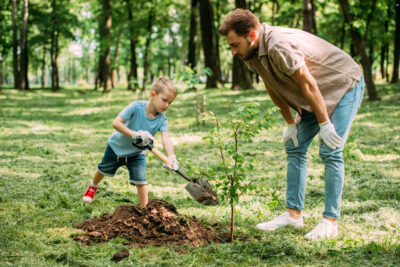
Water conservation is a major issue that is being addressed today in our world. One effective solution lies in the planting of wildlife-friendly trees and shrubs. These plants not only provide habitat and resources for local wildlife but also play a significant role in conserving water and maintaining the health of our watersheds.
How Trees and Shrubs Conserve Water
- The root systems of trees and shrubs help to reduce soil erosion, which is caused by wind and water due to severe weather. Retaining water in your landscape can be difficult if you do not have trees and shrubs strategically planted in your garden. Your soil may look like a mess after a severe rainstorm. If you plant trees and shrubs, you’ll allow water to store in the soil, rather than running off.
- Reducing evaporation in your soil is necessary for your garden to get the water it needs. Trees and shrubs provide the proper shade for the water to sink into the healthy topsoil and get what it needs for crucial water conservation. This will ultimately help your soil to stay strong and healthy, as well as provide your plants drinking water.
- Trees and shrubs facilitate the process of groundwater recharge by allowing rainwater to infiltrate the soil and reach underground aquifers. This process is vital for maintaining the availability of groundwater, which many communities rely on for drinking water and irrigation. Deep-rooted plants are effective at channeling water deep into the ground.
Benefits for Watershed Health
- As water moves through the root zones of trees and shrubs, it is filtered and cleansed of pollutants such as pesticides, fertilizers, and sediments.
- Wildlife-friendly trees and shrubs provide essential habitat and food sources for a variety of species, from insects and birds to mammals and amphibians. A biodiverse landscape is more resilient and better able to withstand environmental stresses, including droughts and floods.
- By enhancing soil structure and increasing water infiltration, trees and shrubs help reduce the volume and speed of surface runoff during heavy rains. This reduction in runoff decreases the risk of flooding and lessens the impact of stormwater on local waterways.
Practical Steps for Planting Wildlife-Friendly Trees and Shrubs
When choosing which trees and shrubs to plant on your landscape, select trees and shrubs that are native to your region, as these plants are best adapted to local soil and climate conditions. Planting them in strategic locations like along slopes, streams, and areas of your garden you see erosion is extremely important. Also, make sure to mix-up the species of trees and shrubs you’re planting. It’s crucial to have a diverse range of native vegetation.
At Cold Stream Farm, we offer trees and shrubs for wholesale at our Michigan farm. We encourage you to look at our inventory to see what you may want to plant for water conservation.
Contact Cold Stream Farm at (231) 464-5809 today and visit us online for tips on planting and ordering trees and shrubs at our farm!
